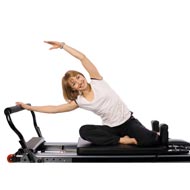- Aromatherapy (36)
- Benefits of Yoga (282)
- Home Remedies (1087)
- massage therapy (9)
- Preventive Therapy (135)
- Running (41)
- Skin Care (15)
- Stress Relief (25)
- Stretching (5)
- walking (33)
- Womens Health (14)
- Yoga Benefits for Pregnant Women (16)
- Yoga Benefits for Students (3)
- Yoga for Children (11)
- Yoga for Holistic Living (37)
- Yoga for Midlife Crisis (3)
- Yoga for Senior Citizens (2)
- Yoga for the Workplace (1)
- Yoga Health Tips (185)
- Yoga Practice during Menstruation (5)
Importance Of Inhaling Through Nose And Exhaling Through Mouth In Pilates

Breathing is an essential component of life. Through this process we ensure that the body is always supplied with enough oxygen, while flushing out processed gases from the system.
When we breathe properly the lungs expand on inhaling; the diaphragm drops and the stomach rises outwards. Similarly, when we exhale, the diaphragm lifts and the stomach is sucked in. This is the proper way to breathe; if you notice, this is how all infants breathe. Yet somewhere along the way as time goes by and we age, we resort to a shallow and jagged form of breathing. We don’t inhale completely and we don’t exhale completely. As a result the adequate amount of oxygen doesn’t get pumped into the body and the waste gases aren’t flush out properly. In such as situation the body feels dull and fatigued. Furthermore, the body produces a high level of adrenaline and as a result stress, causing even more physical symptoms to spring up.
Therefore, it isn’t surprising to know that our breathing has a direct impact on how we feel and move. It is for this reason that many body-mind fitness disciplines promote and incorporate deep breathing techniques into their routine. Pilates is one such discipline.
Pilates is a fitness program that was developed in the 1920’s. It focuses on corrective and conditioning exercises that aim to strengthen the body by working and developing its core strength – the abdominal and pelvic floor muscles. Proper breathing is a basic component of the Pilates regime.
Unlike yoga which promotes deep breathing through the nose, the basic rule for breathing while practicing Pilates is - breathe in through the nose and breathe out through the mouth. The fundamental plot of Pilates is to strengthen the body’s core – the central muscles that support much of the body. And the Pilates breathing technique too is designed to support this cause. Pilates breathing involves the contraction of the abdominal muscles, which by doing so strengthen them.
It is a known fact that breathing through the nose is important to prevent dust and other foreign particles from reaching the lungs. Inhaling through the nose ensures that the air is warm and properly filtered. Through the process of deep breathing oxygen reaches the lowest parts of the lungs, a part that is often unused due to improper breathing. This is part one of the Pilates breathing process.
Part two involves exhaling through your mouth. Breathing out through the mouth is referred to as forced expiration. This process is known to energize and replenishes the body. Furthermore, exhaling through the mouth involves the use of abdominal contractions, which plays an important part in building the body’s core strength – the main focus of Pilates.
In addition, proper breathing technique is necessary in Pilates to achieve controlled movement for the exercise to be precise and beneficial; it also dictates the intensity of the workout. The Pilates breathing techniques work towards relaxing the body by unraveling the tension and stress present in the body. It results in a more effective flow of oxygen to all the vital organs of the body. This boosts circulation, immunity and vitality. Furthermore by engaging the abdominal muscles in the daily process of breathing, it helps to develop the body’s core.
- RSS Feeds -
- All posts
- All comments
- Breathing Techniques For Swimmers The importance of the right swimming breathing and ...
- Choosing the Right Pilates Workout The Pilates technique was first invented by a German doctor, Joseph Pilates. ...
- Pilates- Balance Ball Workout Practicing yoga or Pilates is very healthy for your body. Practicing differen...
- Adho Mukha Vrksasana Overview When we take each word of this asana and look for the meaning it comes out to...